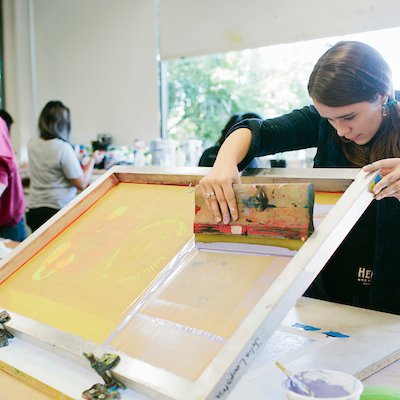ChatGPT said: Inside look at 10:9 Design LLC Company screen printing process
Wiki Article
The Necessary Overview to Recognizing Screen Printing and Its Versatile Uses
Screen printing has an abundant background that dates back to old times, advancing into an innovative method made use of throughout numerous industries today. This overview explores the ins and outs of the screen printing procedure, outlining its applications in fashion, home, and advertising and marketing design - 10:9 Design near me. Understanding these principles can open innovative possibility for both business and imaginative tasks. The adhering to sections will expose crucial pointers and techniques to enhance one's screen printing endeavorsThe Background of Screen Printing
Although screen printing has roots that trace back centuries, its advancement reflects the technical and imaginative innovations of numerous societies. Stemming in old China, the technique was originally utilized for decorating fabrics and later spread to Japan, where it became essential to Ukiyo-e woodblock printing. The method changed to Europe in the 18th century, where it acquired appeal amongst artisans and industrial printers. The innovation of picture emulsion in the 20th century changed screen printing, enabling for more complex designs and better efficiency. Musicians like Andy Warhol additionally pushed its popularity, utilizing the tool to produce legendary works that combined commercialism and fine art. By the late 20th century, screen printing had established itself as a flexible method, employed in vogue, advertising, and great art. Today, it continues to develop, incorporating digital innovation and broadening its applications across different sectors.The Screen Printing Process Explained
Screen printing transforms imaginative visions into tangible layouts through a collection of specific steps. An image is produced and after that moved onto a screen, usually made of great mesh textile extended over a frame. A light-sensitive emulsion is put on the screen, which is subjected to light, setting in areas not covered by the image. After rinsing the unhardened solution, a stencil is formed.Next, the screen is placed over the substrate, whether it be material, paper, or an additional product. Ink is after that pressed via the open areas of the stencil utilizing a squeegee, transferring the style onto the substratum listed below. This procedure can be duplicated for several shades, calling for different displays for each and every hue. Finally, the printed item is cured using warm to ensure the ink adheres correctly, leading to a long lasting, lively style prepared for use.
Sorts Of Screen Printing Techniques

Furthermore, specialized strategies, such as discharge screen printing, remove color from the textile to develop softer prints, while aluminum foil screen printing uses metallic aluminum foil to accomplish a glossy surface (10:9 Design Screen Printing). Each method uses unique attributes, catering to numerous imaginative needs and production ranges, inevitably broadening the opportunities within the screen printing domain name
Applications of Screen Printing in Various Industries
Additionally, the signs and advertising and marketing sectors make use of screen printing for producing eye-catching display screens and banners. This technique enables vibrant colors and elaborate layouts that catch focus. In electronics, screen printing is employed for applying conductive inks to circuit card, vital for component connections. The home décor sector embraces screen printing to generate distinct layouts on textiles and wall art. Overall, screen printing functions as a vital tool across diverse areas, enhancing items with personalized and aesthetically appealing graphics.
Tips for Effective Screen Printing Projects
While taking on a screen printing task, cautious interest to information can significantly enhance the last end result. Initially, selecting high-quality materials is crucial; this consists of the screen, inks, and substratums. Utilizing ideal mesh counts can influence ink deposition and detail resolution. Preparation is similarly important; comprehensive cleaning of displays and proper exposure times ensure crisp prints.Next off, accurate registration is critical for multi-color prints. Using positioning tools can help attain specific layering. Furthermore, screening prints on scrap products before manufacturing helps identify potential problems without wasting sources.

Frequently Asked Questions
What Products Are Best for Screen Printing on Textile?
Cotton and polyester blends are optimal for screen printing on fabric as a result of their durability and ink absorption. Furthermore, specialized fabrics like silk or canvas can create special textures and surfaces, improving the total style top quality.How Do I Clean and Maintain Screen Printing Equipment?
To clean and preserve screen printing tools, one must regularly wash displays with ideal solvents, examine squeegees for wear, oil moving components, and store all products in a completely dry, dust-free environment to prolong their life-span.What Are the Environmental Effects of Screen Printing?
Screen printing can have substantial environmental effects, consisting of chemical waste from inks and solvents, water usage during cleansing procedures, and power intake. Eco-friendly materials and lasting techniques are vital for decreasing these adverse effects.Can Screen Printing Be Done in your home Successfully?
Screen printing can be effectively done at home with the best materials and methods. Enthusiasts can produce top quality prints, though success relies on their ability degree, tools, and understanding of the procedure entailed.
What Are the Costs Connected With Starting a Screen Printing Company?

Starting a screen printing company involves prices for tools, products, and office. Preliminary costs generally range from a couple of hundred to a number of thousand dollars, depending on the range, high quality of equipment, and wanted production capacity.
Screen printing has a rich background that dates back to ancient times, evolving right into an advanced technique made use of across numerous markets today. Another strategy, rotary screen printing, employs round screens, facilitating continual printing on material rolls, thereby improving performance for large-scale manufacturings. Furthermore, specialized methods, such as discharge screen printing, remove color from the fabric to produce softer prints, while foil screen printing uses metal foil to accomplish a shiny coating. In the fashion market, screen printing is widely made use of to create lively designs on clothing, enabling brand names to showcase their special styles. Cotton and polyester blends are suitable for screen printing on fabric due to their longevity and ink absorption.
Report this wiki page